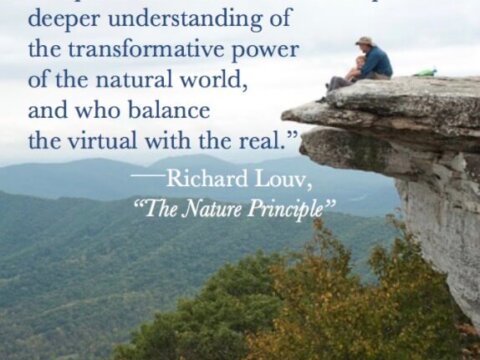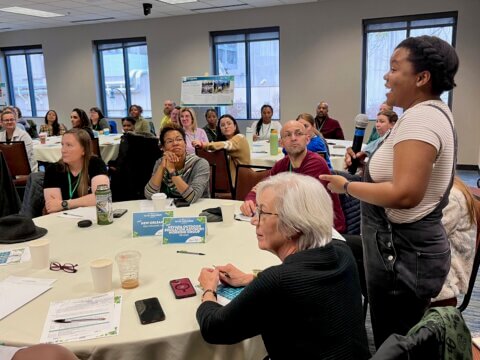From “The Nature Principle”: Is there a “button park” in your future?
Remember the special place in nature that you had as a child —that wooded lot at the end of the cul de sac, that ravine behind your housing tract? What if adults had cared just as much about that special place as you did, when you were a child?
Here’s an idea (described in my new book, The Nature Principle), whose time may be coming: the creation of “nearby-nature trusts.” Land trust organizations could develop and distribute tool kits, and perhaps offer consulting services, to show how neighborhood residents could band together to protect those small green parcels of nearby nature. What might these little parcels be called? How about ” button parks?”
More about my suggested term later, but first let me tell you about the Carolina Thread Trail.
A few weeks ago, I was in Charlotte North Carolina, speaking to a gathering arranged by the Catawba Lands Conservancy, a regional land trust which has protected 7,500 acres. Catawba is also the lead agency for the Carolina Thread Trail, a regional trail network that will eventually weave throughout a huge area of North Carolina and South Carolina, reaching into 15 counties and serving over 2 million people.
The Catawba organization describes the Thread Trail this way: ” Simply put, it will link people and places. It will link cities, towns, and attractions. More than a hiking trail, more than a bike path, the Carolina Thread Trail will preserve our natural areas and will be a place for exploration of nature, culture, science and history, for family adventures and celebrations of friendship. It will be for young and old, athlete and average. This is a landmark project. A legacy that will give so much, to so many, for so long.”
If the full concept survives the legal and political challenges that are inevitable any time good people pursue a vision this large. The Thread Trail is one example of how regions can address what will be, in an urbanizing world, a growing hunger for the health and well-being that nature provides to human beings. In fact, the availability of nearby nature is or should seen as an integral element of our future health care system, for reasons related to both physical and mental health.
When the Trust for Public Land (TPL), working with the Colorado Health Foundation, brought together groups concerned about the disconnect of children from nature, TPL leaders and I brainstormed on the future of land trusts in tough economic times. Considering this approach, one of TPL’s leaders suggested that neighborhood leaders might also identify abandoned houses, buy them, raze them, and turn them into natural parkland or community gardens. ” We really do have to think about creating nature, not just preserving it,” he said.
As with family nature clubs, the central organizing principle of nearby-nature trusts would be: do it yourself, do it now — with a little help and information from friends who know about land trusts.
A larger pattern could emerge: As neighborhoods work to preserve or create parcels of nearby nature, they could symbolically join these special places to similar ones throughout a city; such an effort could be a new way to build parkland across an urban region — a kind of decentral park.
But let me return to this notion of what I call ” button parks.” Why call them that? “Pocket park” is the term for small parks created by governments or developers; button parks — well, people can sew those on themselves.
The term makes particular sense in the Carolinas. The reason that the Carolina Thread Trail is called a thread trail is not only because of the image that word evokes, but because of the Carolinas’ long dependence on the textile industries. In past decades, stitching shirts has given way to circuit chips, but the sense of history remains. Development pressure has brought the need for regional planning, so that the nature connection can continue, especially for children and families in urban and suburbanizing areas.
So, while visiting with the good folks of Catawba, it occurred to me that the Carolina Thread Trail could be strengthened over time, politically and socially, if the people who live adjacent to the trail were to become more directly involved, not only in the use of the trail, but in the concept’s expansion deeper into their own neighborhoods.
What if people had access to free tool kits which helped people create their own ” button parks” connected to the “thread” trail? These button parks wouldn’t need to be literally connected to the trail, but would serve as small extensions of the trail throughout the region.
Barriers would exist, among them the fear of liability. But precedents do exist around the country. When I spoke in Fort Wayne, Indiana, the director of ACRES Land Trust suggested one approach. ACRES has protected natural habitats throughout northeast Indiana, southern Michigan and northwest Ohio. Jason Kissel, executive director of ACRES, suggested that button parks could be created by neighborhood associations, and that, at least in Indiana, public use of private land left in its natural state poses less danger of future litigation than land that has been “improved.”
By going through the process of creating button parks, people would learn about the growing importance of the land trust movement. Potentially, figuring this out could dramatically increase the amount of protected nearby nature. The residents of neighborhoods would be able to take pride in their protection of those little special places, places too small for government or large conservancies to protect, but large in the hearts of children and their families.
-
Feature
GROWING POWER: Urban Roots connects young people with natural spaces, food systems – and one another
-
Feature
Nature photographer Dudley Edmondson has a vision for the representation of Black and Brown faces in the outdoors
-
Network News
Community Spotlight: Prescribe Outside
-
Richard Louv
SPRING FORWARD! 12 Ways to Make Sure Your Kids (and You) Get the Right Dose of VITAMIN N this Spring — and Summer, Too
-
Voices
Placemaking: How to build kinship and inclusive park spaces for children with disabilities







Commentaries on the C&NN website are offered to share diverse points-of-view from the global children and nature movement and to encourage new thinking and debate. The views and opinions expressed are those of the author(s) and do not necessarily reflect the position of C&NN. C&NN does not officially endorse every statement, report or product mentioned.